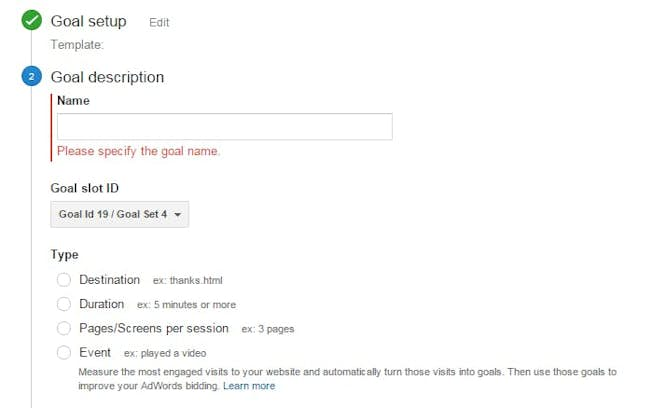What Data Is Google Analytics Goals Unable to Track and Why
Wiki Article
Revealing the Blind Spots: Comprehending What Google Analytics Goals Can not Determine
In the realm of electronic analytics, Google Analytics stands as a powerful tool for tracking and assessing online user communications. Comprehending what Google Analytics goals can not measure is essential for acquiring a detailed view of user habits and engagement.User Actions on External Operatings Systems
Comprehending how customers communicate on external platforms is crucial for enhancing on the internet approaches. Outside platforms, such as social media networks, recommendation websites, and online discussion forums, play a substantial duty in driving website traffic to a business's site. By analyzing individual behavior on these systems, businesses can obtain useful insights right into the performance of their advertising efforts and the preferences of their target market.One trick aspect of individual habits on external systems is the recommendation resource. By tracking where the customers are originating from, businesses can identify which systems are driving the most traffic to their web site. This details can help business allot their sources a lot more successfully, concentrating on the platforms that generate the very best outcomes.

Offline Interactions and conversions
Assessing individual actions on external platforms offers beneficial insights into on the internet approaches; nevertheless, considering offline conversions and interactions is similarly essential for a detailed understanding of a company's general efficiency. While Google Analytics excels at tracking online communications, it drops brief in catching the total customer journey that commonly includes offline touchpoints. Offline conversions, such as in-store purchases or phone questions, play a considerable duty in lots of organizations' success. Overlooking these interactions can result in an altered view of the efficiency of advertising and marketing projects and total organization performance.
Attribution Beyond Last Click
When diving right into the realm of digital advertising and marketing analytics, it becomes necessary to look beyond the solitary touchpoint of the last click for a much more thorough understanding of attribution. While Google Analytics supplies useful understandings right into user habits, relying solely on last-click attribution can be limiting - what data is google analytics goals unable to track. Acknowledgment versions that go past the last click offer a much more nuanced sight of the customer trip, taking into consideration all the touchpoints that result in a conversionAcknowledgment beyond the last click allows marketing experts to designate credit score to numerous interactions along the conversion path, offering a more clear photo of the effectiveness of various advertising channels. By exploring multi-touch attribution designs such as direct, time decay, or position-based attribution, businesses can better allocate their advertising budgets and enhance their techniques for optimal effect.
Comprehending the impact of each touchpoint in the conversion procedure is vital for making informed choices and taking full advantage of ROI. By welcoming acknowledgment past the last click, services can get much deeper understandings into consumer actions and tailor their marketing efforts better.
Cross-Device and Cross-Browser Monitoring

Similarly, cross-browser tracking matches cross-device tracking by recording individual habits as they switch between various web internet browsers. Recognizing how individuals interact with web sites on different web browsers can these details help online marketers optimize their on-line experiences to make sure consistency and functionality across various platforms.
Qualitative Information and Individual Intent
Recognizing individual intent with qualitative information evaluation is important for creating targeted digital advertising and marketing strategies that resonate with the requirements and choices of the target market. Qualitative information supplies insights right into the 'why' behind customer actions, dropping light on motivations, feelings, and preferences that quantitative information alone can not record. By analyzing user comments, remarks, and interactions, marketing experts can discover important info about user intent, enabling them to customize their messaging, material, and offerings to better line up with what their audience is looking for.Qualitative data also helps in recognizing the context in which customers engage with a web site or app. This contextual understanding makes it possible for marketers to produce more appropriate and customized experiences, ultimately driving greater involvement and conversion rates. By diving into user intent with qualitative data analysis, organizations can gain a deeper understanding of their target audience, causing a lot more efficient advertising methods that fulfill customers' expectations and needs.
Verdict
To conclude, Google Analytics objectives have restrictions in determining user actions on external systems, offline conversions, attribution beyond last click, cross-browser and cross-device monitoring, and qualitative information associated to user intent. what data is google analytics goals unable to track. It is essential for companies to be aware of these dead look these up spots in order to supplement their information evaluation with various other tools and methods to obtain an extra comprehensive understanding of their audience and improve their general digital advertising and marketing techniquesBy evaluating customer habits on these systems, companies can gain valuable understandings into the effectiveness of their advertising and marketing initiatives and the preferences of their target audience.
Examining user actions on external platforms gives useful understandings right web into on-line strategies; nevertheless, taking into consideration offline conversions and interactions is just as important for a comprehensive understanding of a business's overall performance.In electronic advertising analytics, moving beyond last-click attribution to explore cross-device and cross-browser monitoring is important for acquiring an alternative understanding of customer communications throughout numerous platforms and tools. By examining individual responses, remarks, and communications, marketing professionals can discover beneficial info regarding user intent, allowing them to customize their messaging, web content, and offerings to much better straighten with what their target market is looking for.
By diving into individual intent with qualitative information analysis, companies can get a deeper understanding of their target audience, leading to a lot more efficient advertising approaches that satisfy users' expectations and needs.
Report this wiki page